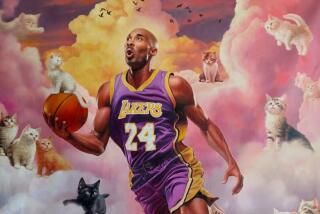SHOW IS THE CATS AT MUSEUM IN S.D.
SAN DIEGO — The Natural History Museum has followed the unprecedented success of its summer dinosaur exhibit with an artistic cat show that figuratively roars, howls and meows in its depiction of the members of felidae, the carnivorous family including cats of all sizes.
The exhibition, dubbed “The Eclectic Cat,” presents the lore, evolution and cultural relevance of cats--big and small, tamed and untamed--by using nature, art and artifact. Individual exhibits range from a 7,000-year-old cat mummy, dated as being from Egypt’s “Cult of the Cat,” to a surrealistically metaphoric painting of two cats by contemporary Tijuana artist Gerardo Navarro.
Conceived by the Museum of Natural History and assembled by David Reutter, the museum’s preparator, the exhibit focuses on cats mainly as portrayed by artists through the ages. There are artifacts from Japan, China and Persia that bear cat figures, and scores of paintings showing how felines have been appreciated by different cultures.
A printed time line, installed on a narrow band above the individual exhibits, makes a handy guide in tracing the evolution and cultural impact of cats from 45 million years ago to the present. On the time line we find tidbits of feline lore, such as the peculiar status of cats in ancient Egypt, where they were revered but were also the “secret weapon in the war against hunger.”
An invading Persian army once captured an Egyptian city without resistance when the Persian soldiers, holding cats to their chests and driving a pack of felines before them, advanced on the Egyptians.
The time line recalls that, in a later epoch, ships such as the Cutty Sark never sailed without a company of cats aboard. The presence of cats was required to maintain valid maritime insurance policies.
Additionally, printed wall panels situated about the exhibit provide more information. We are informed that big cats--lions, tigers, leopards and jaguars--can roar because of the presence of a flexible ligament in the voice box. The ligament vibrates like a bass G string when it is hit by the outrush of air.
A startling anatomical similarity among all cats, from the extinct sabercat to the domestic kitty, is revealed in a display of cat skulls.
Surprisingly, The Eclectic Cat exhibition, which opened last week and runs though Nov. 17, makes a minimum use of natural exhibits. The major portion of the show is composed of works by contemporary artists from Southern California, many of them created especially for this exhibition. Included are works by 20 San Diego area artists, including Robert Smith, photographer Robert Walker and Amanda Farber.
John Brodie’s “100% Cat Parts,” an assemblage of acrylic with staples on polyester and tyvec, is a rare figurative artwork of a black cat by an artist who almost always works in an abstract mode. Tijuana artist Felipe Almada’s two untitled works of mystical dead cats give a feel for a Mexican cultural attitude toward cats and death that is not common north of the border.
In putting the show together, Reutter avoided contemporary photographs and paintings that might be construed as “cute.” He said that idea is picked up, however, in the artifacts and such period pieces as the Currier and Ives lithograph “My Little White Kitties After the Goldfish.” The kitten represented in that lithograph has eyes that are almost human and whiskers that recall men’s Victorian-era mutton chops.
Among the show’s modern artifacts are hand-painted “cels” of Chuck Jones’ animated cartoon characters such as Sylvester the cat (with Tweetie Bird) and Tom (without Jerry) shooting himself in the head with a slingshot. Garfield the cat is represented, as is a red leopard lamp, circa 1950.
The more traditional American views of domestic cats are shown in Ruth Landay’s “Porch Cats.” Los Angeles painter Carlos Almaraz is represented by three large, colorful semi-abstract paintings such as “Leopards Don’t Cry,” which, in its depiction of a nude female figure and a cat-like male, recalls the dark undercurrents of the “Cat People” movie.
A delightful Etruscan, black-figure amphora, dating from 500 B.C., shows a boy playing with or feeding a cat, which stands on its hind legs. The piece was loaned by the Getty Museum. In assembling the exhibition, Reutter drew on the San Diego Museum of Art, local and out-of-town galleries, and the artists themselves.
The exhibit is in a confined space, but is packed with information and a huge amount of fine art by living San Diego artists.
More to Read
The biggest entertainment stories
Get our big stories about Hollywood, film, television, music, arts, culture and more right in your inbox as soon as they publish.
You may occasionally receive promotional content from the Los Angeles Times.










